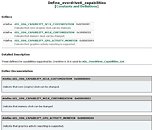- Joined
- Oct 9, 2007
- Messages
- 47,243 (7.55/day)
- Location
- Hyderabad, India
| System Name | RBMK-1000 |
|---|---|
| Processor | AMD Ryzen 7 5700G |
| Motherboard | ASUS ROG Strix B450-E Gaming |
| Cooling | DeepCool Gammax L240 V2 |
| Memory | 2x 8GB G.Skill Sniper X |
| Video Card(s) | Palit GeForce RTX 2080 SUPER GameRock |
| Storage | Western Digital Black NVMe 512GB |
| Display(s) | BenQ 1440p 60 Hz 27-inch |
| Case | Corsair Carbide 100R |
| Audio Device(s) | ASUS SupremeFX S1220A |
| Power Supply | Cooler Master MWE Gold 650W |
| Mouse | ASUS ROG Strix Impact |
| Keyboard | Gamdias Hermes E2 |
| Software | Windows 11 Pro |
While digging through documentation for the latest version of AMD Display Library (ADL), we discovered evidence that AMD is working on a real GPU dynamic overclocking technology akin to NVIDIA's GPU Boost. Such a technology could manipulate GPU (and possibly memory) clock speeds, and voltages across multiple power states, taking into account processing load and temperatures. ADL allows third-party applications low-level interactions with AMD display drivers. Current generation Radeon graphics cards use Overdrive 5 and the feature-set it comes with, and so the new technology, along with Overdrive 6 could feature on upcoming generations of AMD GPUs.
Listed under Overdrive 6 capabilities, AMD documented three new definitions, one which indicates that a GPU's core/engine clock can be changed within a range (ADL_OD6_CAPABILITY_SCLK_CUSTOMIZATION), one that its memory clock can be changed within range (ADL_OD6_CAPABILITY_MCLK_CUSTOMIZATION), and one that monitors its activity/load (ADL_OD6_CAPABILITY_GPU_ACTIVITY_MONITOR). The three are ingredients of a dynamic OC technology in the works.

With its Radeon HD 7970 GHz Edition and Radeon HD 7950 v2, AMD rushed out a feature it calls PowerTune with Boost. This technology follows an archaic method of granting all applications maximum GPU clock (or boost state), while scaling down to nominal (advertised) clock speeds in the event the GPU is overloaded, so most applications run boost state at all time, very few apps actually slow the GPU down. Effectively, this means AMD is setting the boost clock speed too low on current cards, probably being held back by its impact on power draw.
The technology we believe AMD to be experimenting with could follow a method more similar to NVIDIA's GPU Boost. There are no definite clock speeds, but ranges, and the boost clock algorithm instructs the driver to alter clock speeds taking into account load, power draw, and temperatures. Close reading of the API documents also reveal that AMD is working on a dynamic boosting technology for the memory clocks, something that's currently not possible on NVIDIA's products. With AMD GPUs, applying a memory overclock no longer cause the screen to flicker (at least not noticeably).
View at TechPowerUp Main Site
Listed under Overdrive 6 capabilities, AMD documented three new definitions, one which indicates that a GPU's core/engine clock can be changed within a range (ADL_OD6_CAPABILITY_SCLK_CUSTOMIZATION), one that its memory clock can be changed within range (ADL_OD6_CAPABILITY_MCLK_CUSTOMIZATION), and one that monitors its activity/load (ADL_OD6_CAPABILITY_GPU_ACTIVITY_MONITOR). The three are ingredients of a dynamic OC technology in the works.

With its Radeon HD 7970 GHz Edition and Radeon HD 7950 v2, AMD rushed out a feature it calls PowerTune with Boost. This technology follows an archaic method of granting all applications maximum GPU clock (or boost state), while scaling down to nominal (advertised) clock speeds in the event the GPU is overloaded, so most applications run boost state at all time, very few apps actually slow the GPU down. Effectively, this means AMD is setting the boost clock speed too low on current cards, probably being held back by its impact on power draw.
The technology we believe AMD to be experimenting with could follow a method more similar to NVIDIA's GPU Boost. There are no definite clock speeds, but ranges, and the boost clock algorithm instructs the driver to alter clock speeds taking into account load, power draw, and temperatures. Close reading of the API documents also reveal that AMD is working on a dynamic boosting technology for the memory clocks, something that's currently not possible on NVIDIA's products. With AMD GPUs, applying a memory overclock no longer cause the screen to flicker (at least not noticeably).
View at TechPowerUp Main Site
Last edited:




 For even longer than the time they've had turbo actually. They already had something called Cool&Quiet before turbo which dynamically clocks the CPU up&down depending on the load. Turbo is in a way just an extention of that by clocking it up over the default maximum frequency when there is thermal&power room to spare.
For even longer than the time they've had turbo actually. They already had something called Cool&Quiet before turbo which dynamically clocks the CPU up&down depending on the load. Turbo is in a way just an extention of that by clocking it up over the default maximum frequency when there is thermal&power room to spare.


 I wouldn't cool anything over 1.4v for everyday use. Everyone knows that dice and ln2 crazy clock benches are going to require hard-mods (and I'm definitely not setting up a chilled water unit). We, obviously, were not talking about these kinds of setups.
I wouldn't cool anything over 1.4v for everyday use. Everyone knows that dice and ln2 crazy clock benches are going to require hard-mods (and I'm definitely not setting up a chilled water unit). We, obviously, were not talking about these kinds of setups.